Unit 4 I can play basketball. I like me 绘本教案(含教学反思)
文档属性
| 名称 | Unit 4 I can play basketball. I like me 绘本教案(含教学反思) | 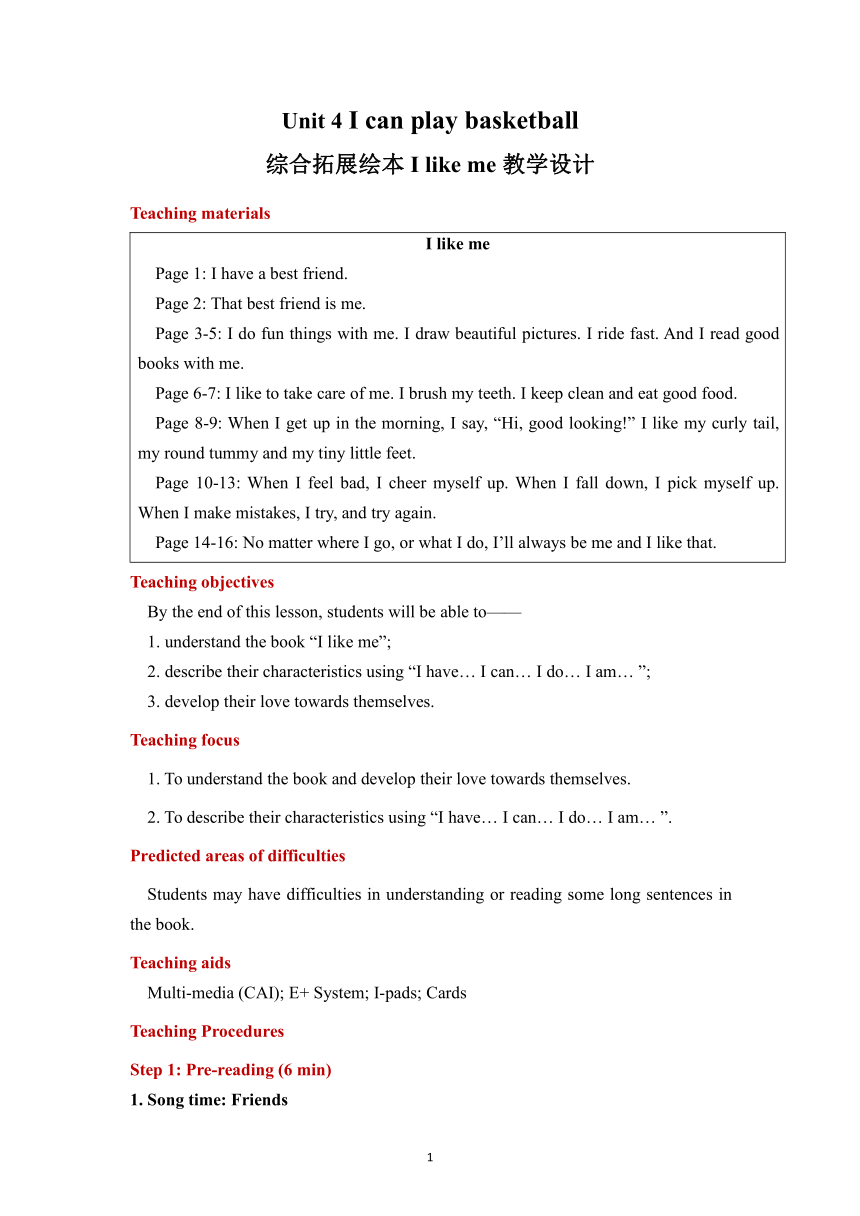 | |
| 格式 | docx | ||
| 文件大小 | 716.3KB | ||
| 资源类型 | 教案 | ||
| 版本资源 | 牛津译林版 | ||
| 科目 | 英语 | ||
| 更新时间 | 2021-10-17 21:48:53 | ||
图片预览

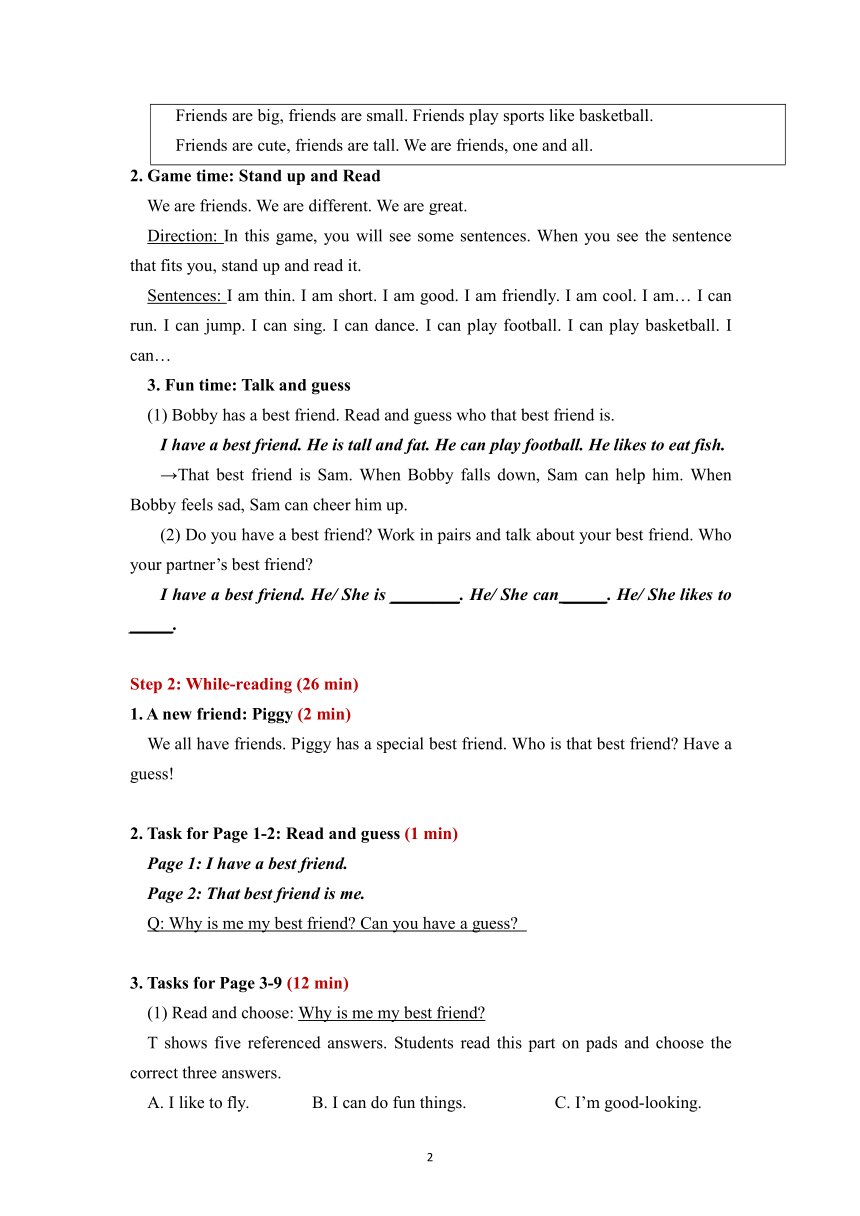
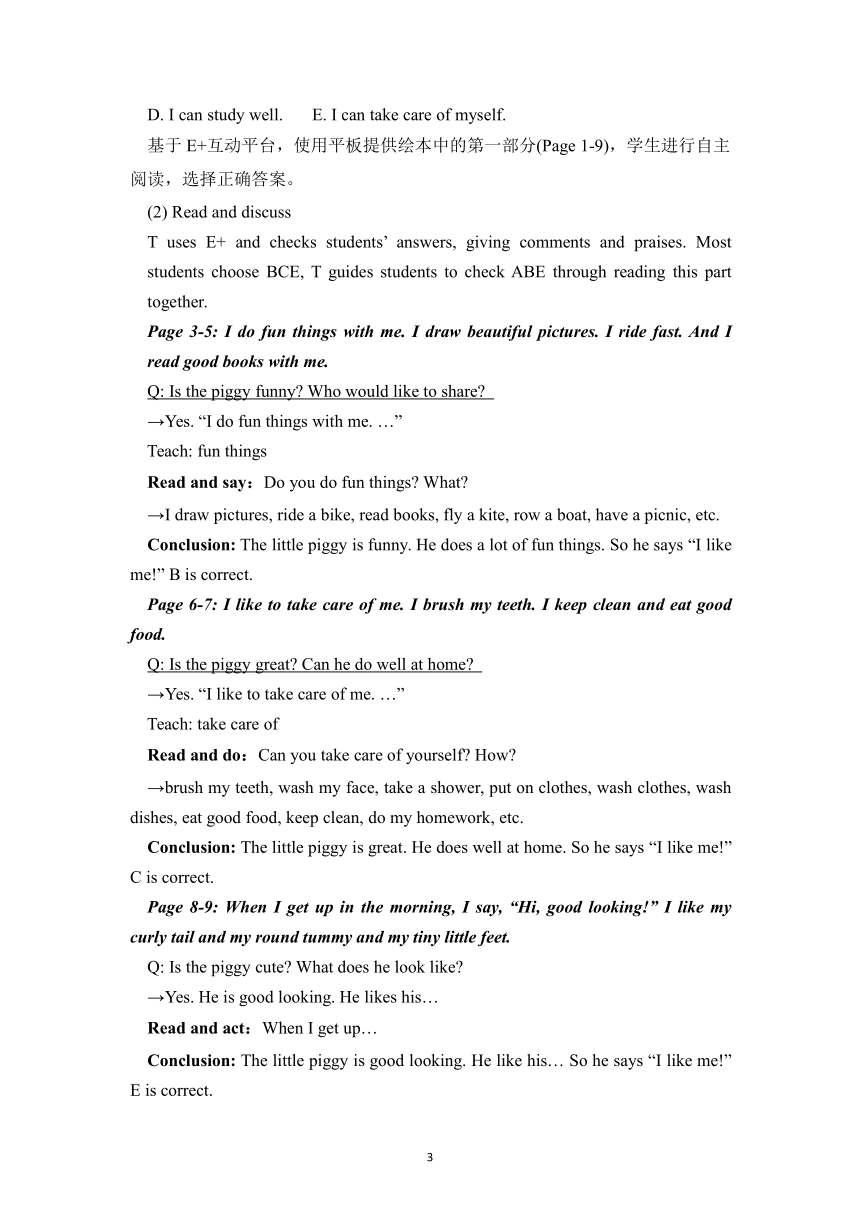
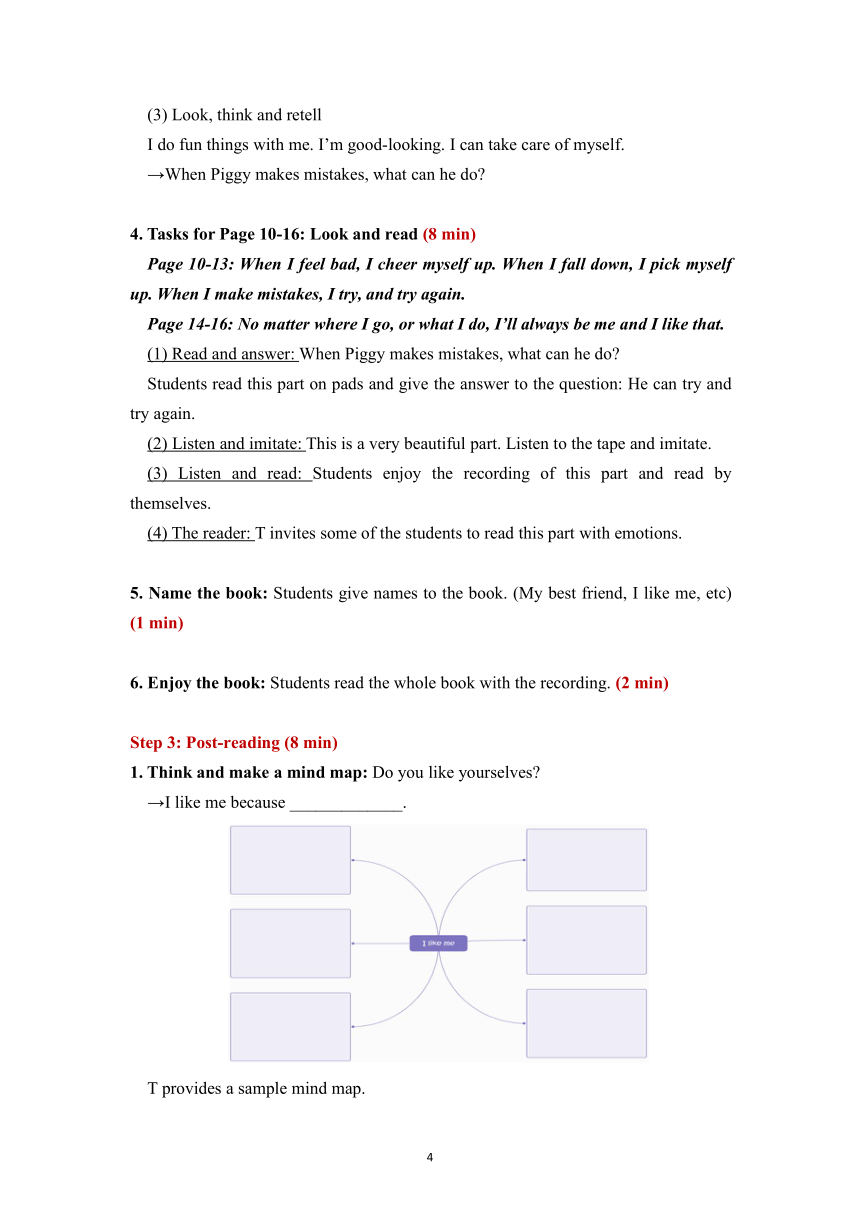
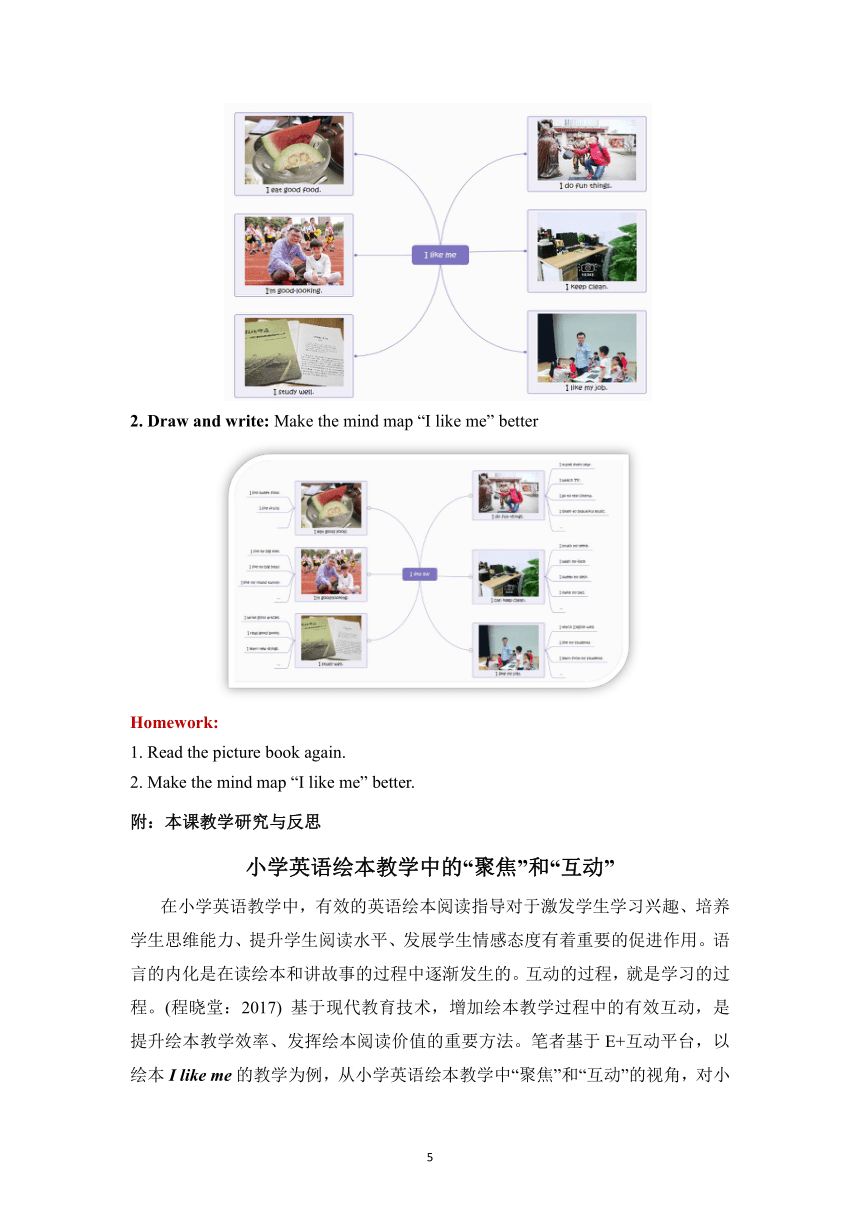
文档简介
Unit 4 I can play basketball
综合拓展绘本I like me教学设计
Teaching materials
I like me Page 1: I have a best friend. Page 2: That best friend is me. Page 3-5: I do fun things with me. I draw beautiful pictures. I ride fast. And I read good books with me. Page 6-7: I like to take care of me. I brush my teeth. I keep clean and eat good food. Page 8-9: When I get up in the morning, I say, “Hi, good looking!” I like my curly tail, my round tummy and my tiny little feet. Page 10-13: When I feel bad, I cheer myself up. When I fall down, I pick myself up. When I make mistakes, I try, and try again. Page 14-16: No matter where I go, or what I do, I’ll always be me and I like that.
Teaching objectives
By the end of this lesson, students will be able to——
1. understand the book “I like me”;
2. describe their characteristics using “I have… I can… I do… I am… ”;
3. develop their love towards themselves.
Teaching focus
1. To understand the book and develop their love towards themselves.
2. To describe their characteristics using “I have… I can… I do… I am… ”.
Predicted areas of difficulties
Students may have difficulties in understanding or reading some long sentences in the book.
Teaching aids
Multi-media (CAI); E+ System; I-pads; Cards
Teaching Procedures
Step 1: Pre-reading (6 min)
1. Song time: Friends
Friends are big, friends are small. Friends play sports like basketball. Friends are cute, friends are tall. We are friends, one and all.
2. Game time: Stand up and Read
We are friends. We are different. We are great.
Direction: In this game, you will see some sentences. When you see the sentence that fits you, stand up and read it.
Sentences: I am thin. I am short. I am good. I am friendly. I am cool. I am… I can run. I can jump. I can sing. I can dance. I can play football. I can play basketball. I can…
3. Fun time: Talk and guess
(1) Bobby has a best friend. Read and guess who that best friend is.
I have a best friend. He is tall and fat. He can play football. He likes to eat fish.
→That best friend is Sam. When Bobby falls down, Sam can help him. When Bobby feels sad, Sam can cheer him up.
(2) Do you have a best friend Work in pairs and talk about your best friend. Who your partner’s best friend
I have a best friend. He/ She is ________. He/ She can _____. He/ She likes to _____.
Step 2: While-reading (26 min)
1. A new friend: Piggy (2 min)
We all have friends. Piggy has a special best friend. Who is that best friend Have a guess!
2. Task for Page 1-2: Read and guess (1 min)
Page 1: I have a best friend.
Page 2: That best friend is me.
Q: Why is me my best friend Can you have a guess
3. Tasks for Page 3-9 (12 min)
(1) Read and choose: Why is me my best friend
T shows five referenced answers. Students read this part on pads and choose the correct three answers.
A. I like to fly. B. I can do fun things. C. I’m good-looking.
D. I can study well. E. I can take care of myself.
基于E+互动平台,使用平板提供绘本中的第一部分(Page 1-9),学生进行自主阅读,选择正确答案。
(2) Read and discuss
T uses E+ and checks students’ answers, giving comments and praises. Most students choose BCE, T guides students to check ABE through reading this part together.
Page 3-5: I do fun things with me. I draw beautiful pictures. I ride fast. And I read good books with me.
Q: Is the piggy funny Who would like to share
→Yes. “I do fun things with me. …”
Teach: fun things
Read and say:Do you do fun things What
→I draw pictures, ride a bike, read books, fly a kite, row a boat, have a picnic, etc.
Conclusion: The little piggy is funny. He does a lot of fun things. So he says “I like me!” B is correct.
Page 6-7: I like to take care of me. I brush my teeth. I keep clean and eat good food.
Q: Is the piggy great Can he do well at home
→Yes. “I like to take care of me. …”
Teach: take care of
Read and do:Can you take care of yourself How
→brush my teeth, wash my face, take a shower, put on clothes, wash clothes, wash dishes, eat good food, keep clean, do my homework, etc.
Conclusion: The little piggy is great. He does well at home. So he says “I like me!” C is correct.
Page 8-9: When I get up in the morning, I say, “Hi, good looking!” I like my curly tail and my round tummy and my tiny little feet.
Q: Is the piggy cute What does he look like
→Yes. He is good looking. He likes his…
Read and act:When I get up…
Conclusion: The little piggy is good looking. He like his… So he says “I like me!” E is correct.
(3) Look, think and retell
I do fun things with me. I’m good-looking. I can take care of myself.
→When Piggy makes mistakes, what can he do
4. Tasks for Page 10-16: Look and read (8 min)
Page 10-13: When I feel bad, I cheer myself up. When I fall down, I pick myself up. When I make mistakes, I try, and try again.
Page 14-16: No matter where I go, or what I do, I’ll always be me and I like that.
(1) Read and answer: When Piggy makes mistakes, what can he do
Students read this part on pads and give the answer to the question: He can try and try again.
(2) Listen and imitate: This is a very beautiful part. Listen to the tape and imitate.
(3) Listen and read: Students enjoy the recording of this part and read by themselves.
(4) The reader: T invites some of the students to read this part with emotions.
5. Name the book: Students give names to the book. (My best friend, I like me, etc) (1 min)
6. Enjoy the book: Students read the whole book with the recording. (2 min)
Step 3: Post-reading (8 min)
1. Think and make a mind map: Do you like yourselves
→I like me because _____________.
T provides a sample mind map.
2. Draw and write: Make the mind map “I like me” better
Homework:
1. Read the picture book again.
2. Make the mind map “I like me” better.
附:本课教学研究与反思
小学英语绘本教学中的“聚焦”和“互动”
在小学英语教学中,有效的英语绘本阅读指导对于激发学生学习兴趣、培养学生思维能力、提升学生阅读水平、发展学生情感态度有着重要的促进作用。语言的内化是在读绘本和讲故事的过程中逐渐发生的。互动的过程,就是学习的过程。(程晓堂:2017) 基于现代教育技术,增加绘本教学过程中的有效互动,是提升绘本教学效率、发挥绘本阅读价值的重要方法。笔者基于E+互动平台,以绘本I like me的教学为例,从小学英语绘本教学中“聚焦”和“互动”的视角,对小学英语绘本阅读教学的策略进行了探析。
一、聚焦绘本,从阅读到意境悦读
优秀的英语绘本能够弥补儿童词汇量较少、语言知识不足的问题,是儿童英语启蒙和学习的重要辅助材料。(吴敏 任逸泓:2016)在绘本教学中,聚焦绘本的图片、语言和其中蕴含的情感,带领学生感受绘本阅读的乐趣、绘本语言的美好、绘本情感的雅致,对于发展学生英语核心素养和综合语言能力有着特别的意义。
1. 关注绘本图片,感受阅读之趣
绘本的显著特点在于其中的图画不是对文字的解释或补充,而是有着独特的价值和功能。绘本中的图画和文字以各自的表意功能协调配合、相辅相成、合体共生,以致不可分割、图文合一。(张敏:2016) 然而,在当前的小学英语绘本教学中,很难做到人手一册绘本,教师往往采用复印、投影的方式带领学生阅读绘本。复印的黑白绘本使得绘本失去了本来的意境和美感,成为了一份普通的阅读材料;投影的绘本只能由教师带着学生“远观”,教学效果大打折扣。那么,如何聚焦绘本图片呢?
在执教译林版《英语》四年级上Unit4 I can play basketball时,笔者将Nancy Carlson的I like me这个温情唯美又生动有趣的绘本作为拓展内容,基于E+互动平台进行专门的教学,取得了很好的效果。基于E+互动平台,笔者将绘本I like me通过Pad端推送给学生,Pad端显示的图片清晰生动,学生通过触屏翻页,能够像阅读纸质书一样进行自主阅读,在阅读中还多了一种翻页和听音的特别体验。课后,笔者还会通过E+互动平台给学生推送相关拓展绘本,学生通过电脑或手机端能够轻松在家随时阅读,他们也不必因为课堂时间和资源的限制而对绘本图片“一蹴而就”。这样基于现代教育技术的互动阅读,为学生提供了更便捷的绘本阅读条件,带领他们观察生动活泼富有童趣的绘本图片,并在图片所创设的丰富语境中感受阅读的乐趣。
2. 欣赏绘本语言,感悟阅读之美
当前小学英语教学中使用的绘本来源相当广泛,有的是原版引进,如外研社的“丽声”系列;有的是本土原创,如译林社的“跟上兔子”系列;还有大量的网络绘本资源。这些绘本语言大多优美地道,有的侧重于语音韵律,如自然拼读系列的绘本,主要功能就是培养学生的音韵意识;有的有的侧重于难度分级,如“跟上兔子”系列,就是结合译林版小学英语教材词汇难度进行分级编写,话题多样、语言贴近学生水平。在教学这些绘本时,教师要和学生一起欣赏绘本语言,引导学生在阅读中感受地道语言的优美,培养他们的阅读兴趣,发展他们的阅读能力。
I like me是一本由Nancy Carlson创作的经典自我认知绘本,其中“I have a best friend. That best friend is me.” “When I get up in the morning, I say, ‘Hi, good looking!’ I like my curly tail, my round tummy and my tiny little feet.” “When I feel bad, I cheer myself up. When I fall down, I pick myself up. When I make mistakes, I try, and try again. No matter where I go, or what I do, I’ll always be me and I like that.” 等一系列富有层次的语言,活泼生动,十分值得咀嚼、品味。基于E+互动平台进行这一绘本的教学时,笔者设计了Read and say, read and dub, read and act等活动,引导学生在互动阅读中辅助交流、配音、表演等形式,进行有感情地绘本欣赏,逐步体会英语语言的优美。
3. 体会绘本情感,领略阅读之雅
当前,大量的英语绘本由于语言功能角度的使用价值,被广泛的用于教学之中,如在语音教学中使用自然拼读系列绘本,在阅读教学中使用视觉词系列绘本等。尽管编写者已经努力让这些“功能性”阅读绘本富有趣味,其中不少难免缺少一些真情实感和趣味灵动。在小学英语绘本教学中,抛开功利性的阅读教学动机,选择一些具有高度艺术性和文学性的原生态绘本,在尊重儿童心灵的成长、发展学生想象力和创造力等方面有着十分重要的意义。
原生态的英语绘本往往紧密联系儿童的生活,是最适合孩子的书,其生动的图画、丰富的选材、动人的语言以及丰富的情感,往往可以给学生注入积极向上的动力,以正确的价值观、情感、态度陶冶学生的情操,I like me就属于这样的绘本。在教学中,笔者通过带领学生图文结合、玩演结合,和小猪Piggy一起发现自己、相信自己、喜欢自己,这是多么有意义的一件事情啊!确实,这样的原生态绘本,语言精练,画面生动,情节自然,体现出了一种既高深又轻浅的儿童哲学,具有高度的艺术性和文学性,衍生出精神上的享受。(严咏梅:2011)
二、聚焦过程,从活动到意义互动
如果把儿童绘本比作一座座小花园,绘本教学的目的就是让孩子身临其境、感受其美、体验其乐。花园里的花瓣和花朵就是语言中的单词和句子,绘本的教学不是要撕下花瓣、摘下花朵带回家。离开了花园的花瓣和花朵,失去的是生命的活力和美的感染力。(杨宇红:2017) 因此,绘本教学的重点并不在于单词和句型的识记和操练,而在于通过有意义的绘本阅读和理解活动,引导学生基于绘本进行有意义的互动,建立Book-Self的关系、Book-World的关系,让学习在绘本阅读中自然发生,让生命在意义互动中自然生长。
1. 关注理解活动,启发思维互动
理解性的活动的开展对于调动学生的思维、发展学生的理解能力有着重要的作用,教师应充分关注这类活动,整体把握绘本,提取关键信息,启发学生的思维互动。在教学I like me时,笔者多次利用理解性的活动,启发学生的思维。
例如,在导入环节,笔者从学生的生活出发,利用游戏和对话引导学生描述自己和朋友的特点,并引入小猪Piggy。通过绘本前两页(“I have a best friend. That best friend is me.”)的阅读,利用E+互动平台进行提问:Why is me my best friend 并提供五个选项,学生利用手中的Pad阅读绘本第一部分后,即时在Pad上提交自己的答案(五选三),教师立刻能够了解学生的理解和做答情况,并选择相应的教学方法进行下一步绘本阅读指导。笔者还设计了Name the book的活动,学生根据自己的理解,踊跃积极参与,分享了诸如My best friend, My best friend is me, I like my best friend, I like me等多个不同的书名,言之成理,发人思考。
2. 依托表达活动,增强语言互动
如果只是机械的引导学生掌握语言中的单词和句子,将绘本作为词汇教学、句型教学甚至语法教学的材料,很难调动学生的学习兴趣和阅读热情。教师应充分尊重学生,调动学生语言表达的积极性,引导他们在互动中融入自己的生活体验,实现学生从“阅读者角色”向“体验者角色”的转变。
在绘本I like me第一部分教学时(I do fun things with me. I draw beautiful pictures. I ride fast. And I read good books with me.) 笔者进行了这样的提问:Piggy does lots of fun things. Do you do fun things Let’s share. 这一表达活动,学生一方面可以参考绘本中的句子进行类似的表达,还可以结合教材和自己的情况进行更丰富的表达,如I play the piano. I play football/ basketball/ table tennis. I read good books. I have picnics. etc. 这样的表达活动设计,不仅为学生提供了存入(记忆)语言的机会,还为学生提取(使用)语言提供了平台,学生在表达中把外部知识变成了自己的知识,在表达中实现了语言的内化。
3. 活化朗读活动,激发情感互动
朗读将声音、文字、意义三者连通,是小学生非常重要的学习活动。(程晓堂:2017) 在经典美文、优美绘本的朗读活动中,除了声音、文字、意义,往往还包含了情感的互动。在中央电视台的《朗读者》节目里,嘉宾们分享自己的人生故事并倾情演绎经典美文,用最平实的情感读出文字背后的价值,展现了有血有肉的真实情感。笔者教学I like me时,就借鉴这一节目设计了“The reader”活动,学生在模仿、自读练习后,手持话筒进行朗读展示,“小朗读者们”或稚嫩、或流畅、或感性的朗读给听众们留下了深刻的印象。此后,“Hello, ladies and gentle men. I’m today’s reader, …”这样的“朗读者招呼语”已经成为班上绘本朗读活动的“标配”,这样朗读的“仪式感”也更加激发了学生的情感互动,帮助他们更加深切的体会绘本语言背后的情感和文化。
儿童世界是一个独特的文化世界,在文化世界中每一个儿童又是独特的存在。因此,针对儿童的教育也应是独特且赋有生命性的。(严咏梅:2011)在英语绘本教学中,活化朗读活动,让传统的Listen and imitate, Listen and read等机械的读转变成带有情感的读,激发学生和绘本之间的情感互动,相信英语课堂上的朗读活动也能和央视《朗读者》节目中的朗读一样,呈现出生命之美、文学之美和情感之美。
三、聚焦输出,从学成到意趣生成
在当前英语绘本课堂上,由于阅读时间的限制、阅读活动设计的不足,在学生对绘本的理解和内化不够时,教师往往又急于输出,经常出现学生语言输出效果不理想的情况。如何引导学生在绘本课堂上有更多、更好的输出呢?
1. 内化文本,让语言输出有意义
在传统教学中,教师很容易将绘本阅读指导当成看图讲故事,缺乏互动,甚至忽略绘本故事情节和其中蕴含的情感。对于目标语的教学,只能采用机械的操练等方式进行突破。实际上,很多的英语绘本都是词真意切,值得我们在教学中举一反三。例如I like me中,Piggy描述自己能做的事情、外貌、照顾自己以及面对困境等情况的表现,运用了大量优美地道的语言,这些文本值得我们聚焦和内化。笔者在教学时通过交流分享活动,不断启发学生内化文本,为他们提取语言和使用语言创设机会——
T: Piggy likes himself. He can…
Ss: He can do fun things. He is good-looking. He can take care of himself. He is brave/ cute/ lovely, etc. (提取)
T: Mm. Piggy likes himself. I like myself too. It is cool to like ourselves. Do you like yourselves
Ss: Of course we do. We all like ourselves.
T: Why
Ss: I can do fun things. I can help others. I can run fast. etc. (使用)
在绘本教学中,教师应尽量在合适的语境下,以多种方式让目标词句自然复现,通过积累有意义的输入,诱发引导孩子自愿输出,才是可持续发展的有效途径。(杨宇红:2017) 这样的分享活动基于学生学情,贴近学生生活,学生参与面广。互动时,学生通过聆听同伴的观点,比较自己的观点,进一步有效地促进了学生知识的自主建构和语言的自然内化,绘本阅读变得十分有意义。
2. 重构语言,让语言输出有意思
传统英语教学只注重阅读技能,而忽视了学生阅读素养的综合发展,造成学生不会阅读、不愿阅读的尴尬局面。(王蔷:2015) 在英语绘本教学时,教师可以适时地结合绘本内容,联系学生生活实际,进行语言重构活动。丰富的语言重构活动可以有效地激活学生的已有语料,激发他们积极表达大胆分享,让绘本教学更有意思。
在I like me中,小猪Piggy喜欢照顾好自己(I like to take care of me. I brush my teeth. I keep clean and eat good food.) 笔者通过提问Can you take care of yourself How 激发学生联系自身、情景交融地进行语言重构,课堂上学生I brush my teeth, wash my face, take a shower, put on clothes, wash clothes, wash dishes, eat good food, keep clean, do my homework等回答,配上他们自创的有趣动作,引人入胜。
3. 走向生活,让语言输出有意趣
儿童文化是创造的文化,儿童世界就是创造的世界。英语绘本阅读和学习可以给孩子们创造自由的精神空间和心灵家园,阅读绘本后的写一写、画一画、涂一涂、想一想、做一做等输出活动,更可以成为孩子实现自我发展、自我成长的平台。
在I like me教学最后,笔者通过设计一张思维导图展示自己的活动,引导学生联系生活、图文结合,写一写、贴一贴、画一画,进行一次比较综合的语言输出。笔者展示了自己的思维导图(如图1),并通过照片、句子为学生提供了必要的语言支架,引导学生将绘本中的语言以及课堂上激活的已有语言运用到思维导图的设计当中。
图1
次日,学生们纷纷向笔者和同学们展示自己的作品。笔者欣喜地看到,大部分学生可以综合运用各种句式描述自己的特点,阐述喜欢自己的理由。有的学生还在一级描述的基础上进行了二级描述(如图2),语言表达十分丰富;有的学生在展示完作品后俏皮地说道,“I like me because I am me!” 这样的句子虽然简单却又充满意趣。在我们的生活中,喜欢自己有时候真是一件不容易的事情,愿几年几十年后,我们都能保持初心,一直喜欢自己、相信自己。
图2
12
综合拓展绘本I like me教学设计
Teaching materials
I like me Page 1: I have a best friend. Page 2: That best friend is me. Page 3-5: I do fun things with me. I draw beautiful pictures. I ride fast. And I read good books with me. Page 6-7: I like to take care of me. I brush my teeth. I keep clean and eat good food. Page 8-9: When I get up in the morning, I say, “Hi, good looking!” I like my curly tail, my round tummy and my tiny little feet. Page 10-13: When I feel bad, I cheer myself up. When I fall down, I pick myself up. When I make mistakes, I try, and try again. Page 14-16: No matter where I go, or what I do, I’ll always be me and I like that.
Teaching objectives
By the end of this lesson, students will be able to——
1. understand the book “I like me”;
2. describe their characteristics using “I have… I can… I do… I am… ”;
3. develop their love towards themselves.
Teaching focus
1. To understand the book and develop their love towards themselves.
2. To describe their characteristics using “I have… I can… I do… I am… ”.
Predicted areas of difficulties
Students may have difficulties in understanding or reading some long sentences in the book.
Teaching aids
Multi-media (CAI); E+ System; I-pads; Cards
Teaching Procedures
Step 1: Pre-reading (6 min)
1. Song time: Friends
Friends are big, friends are small. Friends play sports like basketball. Friends are cute, friends are tall. We are friends, one and all.
2. Game time: Stand up and Read
We are friends. We are different. We are great.
Direction: In this game, you will see some sentences. When you see the sentence that fits you, stand up and read it.
Sentences: I am thin. I am short. I am good. I am friendly. I am cool. I am… I can run. I can jump. I can sing. I can dance. I can play football. I can play basketball. I can…
3. Fun time: Talk and guess
(1) Bobby has a best friend. Read and guess who that best friend is.
I have a best friend. He is tall and fat. He can play football. He likes to eat fish.
→That best friend is Sam. When Bobby falls down, Sam can help him. When Bobby feels sad, Sam can cheer him up.
(2) Do you have a best friend Work in pairs and talk about your best friend. Who your partner’s best friend
I have a best friend. He/ She is ________. He/ She can _____. He/ She likes to _____.
Step 2: While-reading (26 min)
1. A new friend: Piggy (2 min)
We all have friends. Piggy has a special best friend. Who is that best friend Have a guess!
2. Task for Page 1-2: Read and guess (1 min)
Page 1: I have a best friend.
Page 2: That best friend is me.
Q: Why is me my best friend Can you have a guess
3. Tasks for Page 3-9 (12 min)
(1) Read and choose: Why is me my best friend
T shows five referenced answers. Students read this part on pads and choose the correct three answers.
A. I like to fly. B. I can do fun things. C. I’m good-looking.
D. I can study well. E. I can take care of myself.
基于E+互动平台,使用平板提供绘本中的第一部分(Page 1-9),学生进行自主阅读,选择正确答案。
(2) Read and discuss
T uses E+ and checks students’ answers, giving comments and praises. Most students choose BCE, T guides students to check ABE through reading this part together.
Page 3-5: I do fun things with me. I draw beautiful pictures. I ride fast. And I read good books with me.
Q: Is the piggy funny Who would like to share
→Yes. “I do fun things with me. …”
Teach: fun things
Read and say:Do you do fun things What
→I draw pictures, ride a bike, read books, fly a kite, row a boat, have a picnic, etc.
Conclusion: The little piggy is funny. He does a lot of fun things. So he says “I like me!” B is correct.
Page 6-7: I like to take care of me. I brush my teeth. I keep clean and eat good food.
Q: Is the piggy great Can he do well at home
→Yes. “I like to take care of me. …”
Teach: take care of
Read and do:Can you take care of yourself How
→brush my teeth, wash my face, take a shower, put on clothes, wash clothes, wash dishes, eat good food, keep clean, do my homework, etc.
Conclusion: The little piggy is great. He does well at home. So he says “I like me!” C is correct.
Page 8-9: When I get up in the morning, I say, “Hi, good looking!” I like my curly tail and my round tummy and my tiny little feet.
Q: Is the piggy cute What does he look like
→Yes. He is good looking. He likes his…
Read and act:When I get up…
Conclusion: The little piggy is good looking. He like his… So he says “I like me!” E is correct.
(3) Look, think and retell
I do fun things with me. I’m good-looking. I can take care of myself.
→When Piggy makes mistakes, what can he do
4. Tasks for Page 10-16: Look and read (8 min)
Page 10-13: When I feel bad, I cheer myself up. When I fall down, I pick myself up. When I make mistakes, I try, and try again.
Page 14-16: No matter where I go, or what I do, I’ll always be me and I like that.
(1) Read and answer: When Piggy makes mistakes, what can he do
Students read this part on pads and give the answer to the question: He can try and try again.
(2) Listen and imitate: This is a very beautiful part. Listen to the tape and imitate.
(3) Listen and read: Students enjoy the recording of this part and read by themselves.
(4) The reader: T invites some of the students to read this part with emotions.
5. Name the book: Students give names to the book. (My best friend, I like me, etc) (1 min)
6. Enjoy the book: Students read the whole book with the recording. (2 min)
Step 3: Post-reading (8 min)
1. Think and make a mind map: Do you like yourselves
→I like me because _____________.
T provides a sample mind map.
2. Draw and write: Make the mind map “I like me” better
Homework:
1. Read the picture book again.
2. Make the mind map “I like me” better.
附:本课教学研究与反思
小学英语绘本教学中的“聚焦”和“互动”
在小学英语教学中,有效的英语绘本阅读指导对于激发学生学习兴趣、培养学生思维能力、提升学生阅读水平、发展学生情感态度有着重要的促进作用。语言的内化是在读绘本和讲故事的过程中逐渐发生的。互动的过程,就是学习的过程。(程晓堂:2017) 基于现代教育技术,增加绘本教学过程中的有效互动,是提升绘本教学效率、发挥绘本阅读价值的重要方法。笔者基于E+互动平台,以绘本I like me的教学为例,从小学英语绘本教学中“聚焦”和“互动”的视角,对小学英语绘本阅读教学的策略进行了探析。
一、聚焦绘本,从阅读到意境悦读
优秀的英语绘本能够弥补儿童词汇量较少、语言知识不足的问题,是儿童英语启蒙和学习的重要辅助材料。(吴敏 任逸泓:2016)在绘本教学中,聚焦绘本的图片、语言和其中蕴含的情感,带领学生感受绘本阅读的乐趣、绘本语言的美好、绘本情感的雅致,对于发展学生英语核心素养和综合语言能力有着特别的意义。
1. 关注绘本图片,感受阅读之趣
绘本的显著特点在于其中的图画不是对文字的解释或补充,而是有着独特的价值和功能。绘本中的图画和文字以各自的表意功能协调配合、相辅相成、合体共生,以致不可分割、图文合一。(张敏:2016) 然而,在当前的小学英语绘本教学中,很难做到人手一册绘本,教师往往采用复印、投影的方式带领学生阅读绘本。复印的黑白绘本使得绘本失去了本来的意境和美感,成为了一份普通的阅读材料;投影的绘本只能由教师带着学生“远观”,教学效果大打折扣。那么,如何聚焦绘本图片呢?
在执教译林版《英语》四年级上Unit4 I can play basketball时,笔者将Nancy Carlson的I like me这个温情唯美又生动有趣的绘本作为拓展内容,基于E+互动平台进行专门的教学,取得了很好的效果。基于E+互动平台,笔者将绘本I like me通过Pad端推送给学生,Pad端显示的图片清晰生动,学生通过触屏翻页,能够像阅读纸质书一样进行自主阅读,在阅读中还多了一种翻页和听音的特别体验。课后,笔者还会通过E+互动平台给学生推送相关拓展绘本,学生通过电脑或手机端能够轻松在家随时阅读,他们也不必因为课堂时间和资源的限制而对绘本图片“一蹴而就”。这样基于现代教育技术的互动阅读,为学生提供了更便捷的绘本阅读条件,带领他们观察生动活泼富有童趣的绘本图片,并在图片所创设的丰富语境中感受阅读的乐趣。
2. 欣赏绘本语言,感悟阅读之美
当前小学英语教学中使用的绘本来源相当广泛,有的是原版引进,如外研社的“丽声”系列;有的是本土原创,如译林社的“跟上兔子”系列;还有大量的网络绘本资源。这些绘本语言大多优美地道,有的侧重于语音韵律,如自然拼读系列的绘本,主要功能就是培养学生的音韵意识;有的有的侧重于难度分级,如“跟上兔子”系列,就是结合译林版小学英语教材词汇难度进行分级编写,话题多样、语言贴近学生水平。在教学这些绘本时,教师要和学生一起欣赏绘本语言,引导学生在阅读中感受地道语言的优美,培养他们的阅读兴趣,发展他们的阅读能力。
I like me是一本由Nancy Carlson创作的经典自我认知绘本,其中“I have a best friend. That best friend is me.” “When I get up in the morning, I say, ‘Hi, good looking!’ I like my curly tail, my round tummy and my tiny little feet.” “When I feel bad, I cheer myself up. When I fall down, I pick myself up. When I make mistakes, I try, and try again. No matter where I go, or what I do, I’ll always be me and I like that.” 等一系列富有层次的语言,活泼生动,十分值得咀嚼、品味。基于E+互动平台进行这一绘本的教学时,笔者设计了Read and say, read and dub, read and act等活动,引导学生在互动阅读中辅助交流、配音、表演等形式,进行有感情地绘本欣赏,逐步体会英语语言的优美。
3. 体会绘本情感,领略阅读之雅
当前,大量的英语绘本由于语言功能角度的使用价值,被广泛的用于教学之中,如在语音教学中使用自然拼读系列绘本,在阅读教学中使用视觉词系列绘本等。尽管编写者已经努力让这些“功能性”阅读绘本富有趣味,其中不少难免缺少一些真情实感和趣味灵动。在小学英语绘本教学中,抛开功利性的阅读教学动机,选择一些具有高度艺术性和文学性的原生态绘本,在尊重儿童心灵的成长、发展学生想象力和创造力等方面有着十分重要的意义。
原生态的英语绘本往往紧密联系儿童的生活,是最适合孩子的书,其生动的图画、丰富的选材、动人的语言以及丰富的情感,往往可以给学生注入积极向上的动力,以正确的价值观、情感、态度陶冶学生的情操,I like me就属于这样的绘本。在教学中,笔者通过带领学生图文结合、玩演结合,和小猪Piggy一起发现自己、相信自己、喜欢自己,这是多么有意义的一件事情啊!确实,这样的原生态绘本,语言精练,画面生动,情节自然,体现出了一种既高深又轻浅的儿童哲学,具有高度的艺术性和文学性,衍生出精神上的享受。(严咏梅:2011)
二、聚焦过程,从活动到意义互动
如果把儿童绘本比作一座座小花园,绘本教学的目的就是让孩子身临其境、感受其美、体验其乐。花园里的花瓣和花朵就是语言中的单词和句子,绘本的教学不是要撕下花瓣、摘下花朵带回家。离开了花园的花瓣和花朵,失去的是生命的活力和美的感染力。(杨宇红:2017) 因此,绘本教学的重点并不在于单词和句型的识记和操练,而在于通过有意义的绘本阅读和理解活动,引导学生基于绘本进行有意义的互动,建立Book-Self的关系、Book-World的关系,让学习在绘本阅读中自然发生,让生命在意义互动中自然生长。
1. 关注理解活动,启发思维互动
理解性的活动的开展对于调动学生的思维、发展学生的理解能力有着重要的作用,教师应充分关注这类活动,整体把握绘本,提取关键信息,启发学生的思维互动。在教学I like me时,笔者多次利用理解性的活动,启发学生的思维。
例如,在导入环节,笔者从学生的生活出发,利用游戏和对话引导学生描述自己和朋友的特点,并引入小猪Piggy。通过绘本前两页(“I have a best friend. That best friend is me.”)的阅读,利用E+互动平台进行提问:Why is me my best friend 并提供五个选项,学生利用手中的Pad阅读绘本第一部分后,即时在Pad上提交自己的答案(五选三),教师立刻能够了解学生的理解和做答情况,并选择相应的教学方法进行下一步绘本阅读指导。笔者还设计了Name the book的活动,学生根据自己的理解,踊跃积极参与,分享了诸如My best friend, My best friend is me, I like my best friend, I like me等多个不同的书名,言之成理,发人思考。
2. 依托表达活动,增强语言互动
如果只是机械的引导学生掌握语言中的单词和句子,将绘本作为词汇教学、句型教学甚至语法教学的材料,很难调动学生的学习兴趣和阅读热情。教师应充分尊重学生,调动学生语言表达的积极性,引导他们在互动中融入自己的生活体验,实现学生从“阅读者角色”向“体验者角色”的转变。
在绘本I like me第一部分教学时(I do fun things with me. I draw beautiful pictures. I ride fast. And I read good books with me.) 笔者进行了这样的提问:Piggy does lots of fun things. Do you do fun things Let’s share. 这一表达活动,学生一方面可以参考绘本中的句子进行类似的表达,还可以结合教材和自己的情况进行更丰富的表达,如I play the piano. I play football/ basketball/ table tennis. I read good books. I have picnics. etc. 这样的表达活动设计,不仅为学生提供了存入(记忆)语言的机会,还为学生提取(使用)语言提供了平台,学生在表达中把外部知识变成了自己的知识,在表达中实现了语言的内化。
3. 活化朗读活动,激发情感互动
朗读将声音、文字、意义三者连通,是小学生非常重要的学习活动。(程晓堂:2017) 在经典美文、优美绘本的朗读活动中,除了声音、文字、意义,往往还包含了情感的互动。在中央电视台的《朗读者》节目里,嘉宾们分享自己的人生故事并倾情演绎经典美文,用最平实的情感读出文字背后的价值,展现了有血有肉的真实情感。笔者教学I like me时,就借鉴这一节目设计了“The reader”活动,学生在模仿、自读练习后,手持话筒进行朗读展示,“小朗读者们”或稚嫩、或流畅、或感性的朗读给听众们留下了深刻的印象。此后,“Hello, ladies and gentle men. I’m today’s reader, …”这样的“朗读者招呼语”已经成为班上绘本朗读活动的“标配”,这样朗读的“仪式感”也更加激发了学生的情感互动,帮助他们更加深切的体会绘本语言背后的情感和文化。
儿童世界是一个独特的文化世界,在文化世界中每一个儿童又是独特的存在。因此,针对儿童的教育也应是独特且赋有生命性的。(严咏梅:2011)在英语绘本教学中,活化朗读活动,让传统的Listen and imitate, Listen and read等机械的读转变成带有情感的读,激发学生和绘本之间的情感互动,相信英语课堂上的朗读活动也能和央视《朗读者》节目中的朗读一样,呈现出生命之美、文学之美和情感之美。
三、聚焦输出,从学成到意趣生成
在当前英语绘本课堂上,由于阅读时间的限制、阅读活动设计的不足,在学生对绘本的理解和内化不够时,教师往往又急于输出,经常出现学生语言输出效果不理想的情况。如何引导学生在绘本课堂上有更多、更好的输出呢?
1. 内化文本,让语言输出有意义
在传统教学中,教师很容易将绘本阅读指导当成看图讲故事,缺乏互动,甚至忽略绘本故事情节和其中蕴含的情感。对于目标语的教学,只能采用机械的操练等方式进行突破。实际上,很多的英语绘本都是词真意切,值得我们在教学中举一反三。例如I like me中,Piggy描述自己能做的事情、外貌、照顾自己以及面对困境等情况的表现,运用了大量优美地道的语言,这些文本值得我们聚焦和内化。笔者在教学时通过交流分享活动,不断启发学生内化文本,为他们提取语言和使用语言创设机会——
T: Piggy likes himself. He can…
Ss: He can do fun things. He is good-looking. He can take care of himself. He is brave/ cute/ lovely, etc. (提取)
T: Mm. Piggy likes himself. I like myself too. It is cool to like ourselves. Do you like yourselves
Ss: Of course we do. We all like ourselves.
T: Why
Ss: I can do fun things. I can help others. I can run fast. etc. (使用)
在绘本教学中,教师应尽量在合适的语境下,以多种方式让目标词句自然复现,通过积累有意义的输入,诱发引导孩子自愿输出,才是可持续发展的有效途径。(杨宇红:2017) 这样的分享活动基于学生学情,贴近学生生活,学生参与面广。互动时,学生通过聆听同伴的观点,比较自己的观点,进一步有效地促进了学生知识的自主建构和语言的自然内化,绘本阅读变得十分有意义。
2. 重构语言,让语言输出有意思
传统英语教学只注重阅读技能,而忽视了学生阅读素养的综合发展,造成学生不会阅读、不愿阅读的尴尬局面。(王蔷:2015) 在英语绘本教学时,教师可以适时地结合绘本内容,联系学生生活实际,进行语言重构活动。丰富的语言重构活动可以有效地激活学生的已有语料,激发他们积极表达大胆分享,让绘本教学更有意思。
在I like me中,小猪Piggy喜欢照顾好自己(I like to take care of me. I brush my teeth. I keep clean and eat good food.) 笔者通过提问Can you take care of yourself How 激发学生联系自身、情景交融地进行语言重构,课堂上学生I brush my teeth, wash my face, take a shower, put on clothes, wash clothes, wash dishes, eat good food, keep clean, do my homework等回答,配上他们自创的有趣动作,引人入胜。
3. 走向生活,让语言输出有意趣
儿童文化是创造的文化,儿童世界就是创造的世界。英语绘本阅读和学习可以给孩子们创造自由的精神空间和心灵家园,阅读绘本后的写一写、画一画、涂一涂、想一想、做一做等输出活动,更可以成为孩子实现自我发展、自我成长的平台。
在I like me教学最后,笔者通过设计一张思维导图展示自己的活动,引导学生联系生活、图文结合,写一写、贴一贴、画一画,进行一次比较综合的语言输出。笔者展示了自己的思维导图(如图1),并通过照片、句子为学生提供了必要的语言支架,引导学生将绘本中的语言以及课堂上激活的已有语言运用到思维导图的设计当中。
图1
次日,学生们纷纷向笔者和同学们展示自己的作品。笔者欣喜地看到,大部分学生可以综合运用各种句式描述自己的特点,阐述喜欢自己的理由。有的学生还在一级描述的基础上进行了二级描述(如图2),语言表达十分丰富;有的学生在展示完作品后俏皮地说道,“I like me because I am me!” 这样的句子虽然简单却又充满意趣。在我们的生活中,喜欢自己有时候真是一件不容易的事情,愿几年几十年后,我们都能保持初心,一直喜欢自己、相信自己。
图2
12
